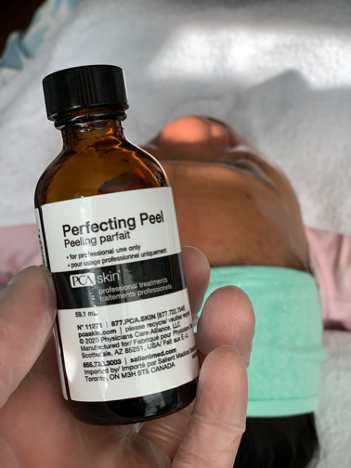Chemical Peel
A chemical peel is a skin resurfacing treatment used to improve skin tone, imperfections and texture by applying a peeling solution to the skin to exfoliate the superficial layers.
What can be treated with chemical peel?
Chemical peels are ideal for eliminating skin imperfections such as;
- Pigmentation irregularities
- Dull complexions
- Scars
- Acne
- Post inflammatory scars
- Melasma
- Sun-damaged skin
- Aging skin
- Clogged pores
- Rough-textured skin / uneven- textured skin
- Fine lines and wrinkles
How long will a chemical peel treatment take?
A Chemical peel treatment can be completed in a 30 minute appointment.What can you expect during a chemical peel procedure?
During the procedure, your skincare specialist will clean and prep the skin for treatment. Using a brush, cotton swab or gauze a peeling solution is applied to the skin. You may feel stinging while the solution is on your skin. This is followed by a neutralizing solution or wash to remove chemical peel from the treated skin.
How many chemical peels will I need?
On average, three to six treatments are recommended to achieve optimal results, but this will depend on the condition you’re treating.
What happens after the treatment?
After a chemical peel treatment, you will experience mild redness and will feel slightly sunburned. The purpose of the chemical peel is to initiate the outer layers of the skin to peel off. It can take approximately three to seven days for the treated area to heal. This may or may not include sloughing of the skin. Your skin care specialist will discuss post treatment care.
What are the intervals between treatments?
A chemical peel treatment can be performed in 3 week intervals.
A chemical peel isn't for everyone. Your provider might caution against a chemical peel or certain types of chemical peels if you:
- Have taken the oral acne medication isotretinoin (Myorisan, Claravis, others) in the past six months
- Have a personal or family history of ridged areas caused by an overgrowth of scar tissue (keloids)
- Are pregnant
- Have frequent or severe outbreaks of cold sores
We also offer enzymatic peels as an alternative to

